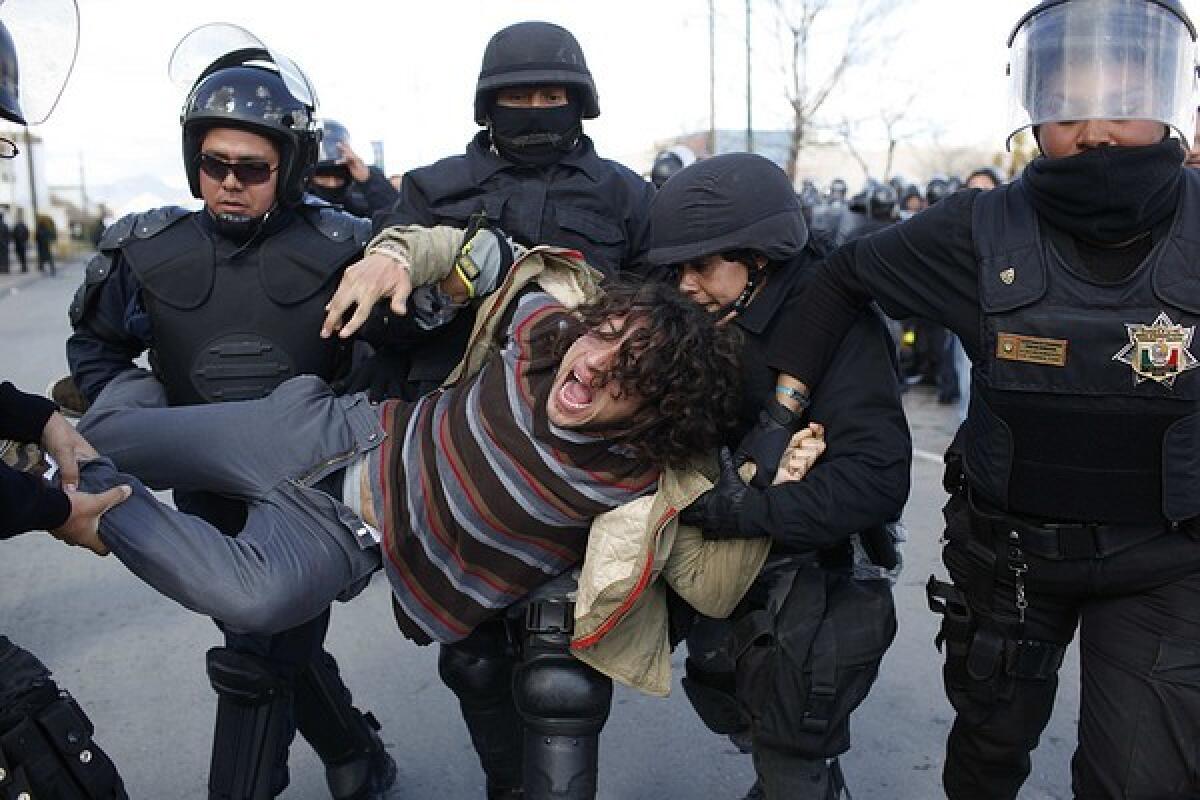Calderon visits Ciudad Juarez

Reporting from Mexico City — Facing intense political pressure and demands that he resign, President Felipe Calderon traveled Thursday to Mexico’s deadliest city to defend his troubled fight against drug cartels, which critics charge has only intensified the violence.
Angry crowds greeted Calderon as he arrived in a heavily guarded Ciudad Juarez. The president said it was time to launch a much-discussed expansion of the drug war to include efforts aimed at tackling social issues, such as unemployment and addiction.
“I am convinced we have to review what we are doing,” Calderon said. “We need a much more integrated approach . . . wider actions . . . of a social nature. Police and military action alone is not enough.”
To underscore the point, Calderon took with him an unusually large contingent of Cabinet members, including the ministers of health, education and public security. However, he was short on details and, in initial remarks, did not earmark money for new programs.
Calderon’s visit to Ciudad Juarez was prompted by the Jan. 31 massacre of at least 15 people, many of them youths, at a high school party, the latest in a spiral of increasingly gruesome bloodshed that has made the city across the border from El Paso a living hell.
Calderon met with relatives of the victims, but many family members refused to see him. They joined large groups of protesters who lined streets and waved signs saying “Apologize, then resign!” Police broke up some of the demonstrations, witnesses said.
In his remarks, Calderon did apologize to families for statements he made in Japan, shortly after the killings, that suggested some of the victims could have been involved in drug gangs.
Later in the president’s speech, a woman rose and shouted that she had lost two children in the killings and that he was not welcome in Ciudad Juarez. “Enough with your war!” she cried.
The expanded program promising jobs and education represented an admission that a guns-only approach has not stopped drug gangs nor reduced killings, especially in Ciudad Juarez. But Calderon has also said he does not plan to withdraw the nearly 10,000 army troops and federal police officers that have been dispatched to the city.
The Calderon administration has long grappled with what to do about Juarez and proposed a new strategy last summer, when government officials acknowledged they were being forced to review procedures that weren’t working.
But they’ve groped for a solution. Even as more troops were poured into the city, the death rate soared, as did accusations of human rights abuses by soldiers. An experimental deployment putting troops into less-visible positions did not improve security markedly. The new plan was devised in July of last year, Juarez Mayor Jose Reyes Ferriz said, and takes many cues from the strategy used to pacify the once-deadly Colombian city of Medellin.
Juarez is a long-neglected city plagued by poverty, corruption and an influx of unskilled workers desperate for jobs. Always saddled with a high homicide rate, especially so for women, the city has seen an exponential increase in killings as drug gangs have battled for turf and innocents have been drawn into the conflict.
Citizens trapped by daily gun battles in the streets and rampant extortion and kidnappings have become so desperate that they recently demanded United Nations peacekeepers, an unheard of thing in nationalistic Mexico, and there have been reports of vigilantism.
Leftist federal senators said this week that they would ask Calderon to consider instituting a curfew in Ciudad Juarez and suspending civil liberties as a way to restore order “in the face of such an extraordinary situation.”
In an editorial titled “Real solutions, Mr. President,” Juarez newspaper El Diario questioned whether the visit was motivated by the looming election season and said blame for the city’s plight rested not only with the presidency but also with state and local officials.
More to Read
Sign up for Essential California
The most important California stories and recommendations in your inbox every morning.
You may occasionally receive promotional content from the Los Angeles Times.











